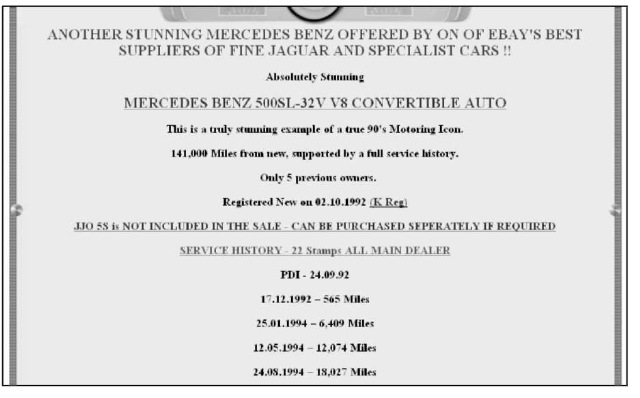In This Chapter
Snapping pretty pictures
Setting perfect pricing
Selling yourself: writing the ultimate description
Anything to add?
Making sure you get paid
Postage and packing
Getting great feedback
Okay, so we’ve given you an entire topic on how to sell well, but this chapter has the key pointers that you should take as gospel if you’re going to be a success on eBay.co.uk. has quizzed some of the UK’s most successful eBay sellers to find out the secrets of their success, most of which, as it turns out, are really simple – but hugely effective.
Take Great Pictures
To be a great eBay.co.uk seller, you’ve got to have great pictures. eBay sellers I’ve spoken to can’t emphasise enough how important it is to get clear shots of what you’re selling. After all, you can wax on forever about how good your item is, but if looks dodgy, then people ain’t gonna bid on it!
If you’re serious (and you should be), think carefully about where you take your pictures. Good light is a must, and you can get this by investing in some basic lighting equipment or simply by using a room that enjoys good natural light.
What’s going on behind your item is also important. In terms of background, less is more. Ideally you want nothing at all, a white screen background is good for focusing attention on your item. A good rule of thumb is that if more is going on in the background than in the foreground, you may want to rearrange your set-up.
You don’t need an all-singing, all-dancing, 20-mega-pixel camera to get good shots – but it does have to be digital. If in doubt, ask around a few of your local photography shops which camera is best for posting online, then buy it on eBay. See Figure 19-1 for an example of a good snap.
Chapter 11 offers advice on taking great digital pictures for online auctions. Keep the following checklist in mind as well to get the best out of your photography:
Make sure there s lots of light.
Remove anything attention-grabbing from the background.
Position the item so that people can see it clearly.
Take several photos and use the best ones.
Don’t use a camera phone; they make things look smudged.

Figure 19-1:
A nice picture from eBay.co.uk PowerSeller CodeNine.
Assessing Your Market – Will It Sell?
When it comes to researching your market on eBay.co.uk, normal business rules apply. If you don’t put in some legwork before you set up your shop, you’ll suffer in the long run. It’s no good deciding to sell watches, for example, if there are already 100 full-time professional watch retailers pumping out high quality Rolexes, Casios and Swatches on the cheap.
Just like any business, you have to make sure that there is a sufficient gap in your market and also that there’s enough demand for what you want to sell. If not, then you may find yourself with a ton of unsold merchandise.
The best way to conduct research is to check out who’s already buying and selling your product lines on eBay.co.uk. A simple keyword search should suffice, along with a search of completed auctions so you can get a feel for your items’ sale value.
Ask yourself the following questions: who’s selling the same product as you? How much for? How often are they doing it? At what time during the day and what day of the week are items most likely to get snapped up for a high price?
By gaining a complete picture of your market before you start selling, you’ll effectively hit the ground running. Trust us, it’ll make you a better seller. See Chapter 7 for more tips on researching your market.
Assessing Yourself (Can You Do It?)
Being inspired to set up an eBay.co.uk business is one thing, but committing to the business is quite another. When you see successful sellers making money it’s tempting to copy them, but they are committed and you should be too.
Being an eBay.co.uk PowerSeller is a high-pressure job. It is demanding on your time and energy -when you’re not listing items and sending out parcels, you’re answering queries and maintaining your Web site. Be prepared to put in the hours; if you’re not happy with this commitment, then stop now!
Setting Perfect Pricing
Price your items too high and you’ll scare people away, but price them too low and people may doubt the quality of what you’re selling. Pricing – like auction length – is an exact science in a variable eBay environment. You have to get it right, especially if you want to include a ‘Buy it Now’ price (see Chapter 10 for more info on this).
Once again, the key to getting your price right is doing some research. Take a look at what price your item has gone for in the past, who bought it and when the auction ended. Use this info to set your own price, as well as your auction length and on what day it starts. See what I mean about exact science?
Describing Your Items
Another way of adding value to your auctions lies in how you describe the stuff you’re selling. Of course, saying that an item is ‘old and shabby’ isn’t going to earn it much interest from buyers, but over-egging it could have the same negative effect.
Don’t say it’s the best thing since sliced bread unless it actually is. Be positive and enthusiastic in your descriptions, by all means, but you must be realistic too.
Overstating the worth of your item may win you a few extra pounds initially, but you’ll soon get a bad reputation and that small gain will be cancelled out by the cost of returns and negative feedback.
When it comes to expensive auctions, like cars, furniture or holidays, the lengthier the description the better. People simply won’t go for a description like, “car, very fast”. They want to know about service history, mileage, addons and so on; few will risk bidding on something they know little about.
Figure 19-2 is a good example of what you should include.

Figure 19-2:
The beginning section of an auction for a sparkly Mercedes Benz.
Anything to Add?
Simply write out your auction without any pictures, bold face or emphasis, and you probably won’t get the right money. On a Web site where millions of items are sold every year, it’s a good idea to make yours stand out.
We talked about pictures earlier in this chapter, but it’s worth restating their importance. While the phrase ‘no picture, no sale’ is not quite true, you can bet that plenty of potential buyers will skip over your auction unless it has a picture to draw their eye.
A good rule of thumb is the more valuable your auction, the more money you should spend on it. If you’re selling an expensive piece of antique furniture, then people are likely to want plenty of evidence that it is what you say it is.
Depending on your item (and what your rivals are doing) you might want to add a few further frills:
Listing it in bold face for 70p. Items in bold are eye-catching – as long as they’re not surrounded by other bold typeface auctions.
If you want to appear in your category’s Featured Item section and in a bidder’s search results use the FeaturedPlus! option. You can find it under featured auctions on the eBay.co.uk home page.
Emphasise your listing with a purple coloured band. Be warned, this costs £1.50 and will not help your auction stand out if other eBayers have the same idea.
Making ‘em Pay Up
To avoid confusion, state your terms and conditions clearly on the auction. If you don’t want your buyers to pay through PayPal, then say it explicitly -most buyers just assume you do.
And, even if you do want them to pay through PayPal, it’s good to give buyers at least one alternative method, say by cheque or postal order. That should guarantee that your auctions will be considered by the widest possible pool of people.
When the auction ends, send the winning bidder a note thanking them for their interest and congratulating them on winning the auction. As an aside you should include an invoice for the full amount owed including postage and packaging.
If there’s no response, don’t start threatening negative feedback – that’ll get you nowhere – be patient and calm. Entice payment rather than demand it, and most people will oblige by sending you the money. Go to Chapter 12 for complete details of the payment process, including what to do if a bidder simply won’t pay up.
Packaging Precious Products
If you want repeat business, make sure your customers get their items in one piece (unless, of course, they’re buying a set). You don’t have to go far on eBay.co.uk to find a seller with negative feedback because their stuff has arrived in bits.
It’s pretty straightforward really. If you’re posting something that’s fragile, then make sure it’s not going to break. Polystyrene beads, egg boxes and cotton wool are your friends here – use them!
If you’re serious about developing customer loyalty, get some leaflets printed up and pop one in each parcel you send out. Big online retailers use this tactic to remind customers where they bought from and to show off other product lines – there’s no reason why you shouldn’t do the same.
Keep Communicating
It’s the best way to make customers feel relaxed. Imagine paying for an item (especially if it’s expensive) and then hearing nothing for a week. You’d start to get nervous, wouldn’t you!? It’s best to allay these fears with a few well-timed updates informing your customer that you’ve received payment and the goods are in the post.
Another nice touch is to send a message to your customer a week after posting them your item. You enquire whether they received it all right and if you could have done anything better, then refresh their memories about the rest of the stuff you have for sale.
Sell Everything for £1
If your cupboards are overflowing with stuff you can’t sell, it might be time for a clear out. Stick it on eBay.co.uk at a starting bid of £1 with no reserve and see what happens!
